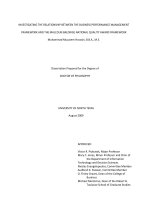Lecture Performance management: Session 16 - Osman Bin Saif
Bạn đang xem bản rút gọn của tài liệu. Xem và tải ngay bản đầy đủ của tài liệu tại đây (394.27 KB, 39 trang )
LECTURE:
SIXTEEN
HRM-755
PERFORMANCE
MANAGEMENT
OSMAN BIN SAIF
1
Summary of Previous Lecture
•
•
Who should provide performance
information?
–
Supervisors
–
Peers
–
Subordinates
–
Self
–
Customers
Disagreement across sources: is this a
2
problem?
Agenda of Today’s Lecture
•
Rater Motivation Model
•
Motivation for Inflated Ratings
•
Motivation for deflated Ratings
•
•
Preventing Conscious Distortion of
Ratings
Preventing Rater Distortion through Rater
Training Programs
3
Rater Motivation Model
Regardless of who rates performance, the
rater is likely to be affected by biases that
distort the resulting ratings.
4
Rater Motivation Model (Contd.)
•
•
Performance ratings may be intentionally
or unintentionally distorted or inaccurate.
When this happens, incorrect decisions
may be made, employees are likely to feel
they are treated unfairly, and the
organization is more prone to litigation.
5
Rater Motivation Model (Contd.)
•
In other words when performance ratings
are distorted, the performance
management system not only fails to
result in desired outcomes but also may
lead to very negative consequences for
the organization.
6
Rater Motivation Model (Contd.)
•
•
To prevent these negative outcomes, we
need to understand why raters are likely to
provide distorted ratings.
A useful model to help us understand the
rater’s motivation to provide accurate
performance information is as following.
7
8
Rater Motivation Model (Contd.)
•
The model shows that rating behaviors are
influenced by;
–
The motivation to provide accurate ratings
–
The motivation to distort ratings.
9
Rater Motivation Model (Contd.)
•
The motivation to provide accurate ratings
is determined by whether the rater expects
positive and negative consequences of
accurate ratings and by whether the
probability of receiving these rewards and
punishments will be high if accurate
ratings are provided.
10
Rater Motivation Model (Contd.)
•
Similarly the motivation to distort ratings is
determined by whether the rater expects
any positive and negative consequences if
ratings are indeed distorted.
11
12
Rater Motivation Model (Contd.)
•
•
There are motivational barriers that
prevent raters from providing accurate
performance information.
Raters may be motivated to distort
performance information and provide
inflated or deflated ratings.
13
Motivation for Inflated Ratings
A supervisor may be motivated to provide
inflated ratings to:
•
Maximize the merit raise/rewards.
–
A supervisor may want to produce the highest
possible reward for his employees and he
knows this will happen if he provides the
highest possible performance ratings.
14
Motivation for Inflated Ratings
(Contd.)
•
Encourage employees
–
A supervisor may believe that employee
motivation will be increased if they receive
high performance ratings.
15
Motivation for Inflated Ratings
(Contd.)
•
Avoid creating a written record
–
A supervisor may not want to leave a paper
trail regarding an employee’s poor
performance because such documentation
may eventually lead to negative
consequences for the employee in question.
–
This situation is possible if the supervisor and
employee have developed a friendship.
16
Motivation for Inflated Ratings
(Contd.)
•
Avoid confrontation with employees
–
A supervisor may feel uncomfortable providing
negative feedback and in order to avoid a
possible confrontation with the employee.
–
Supervisor may decide to take the path of
least resistance and give inflated performance
ratings.
17
Motivation for Inflated Ratings
(Contd.)
•
Promote undesired employees out of unit
–
A supervisor may believe that if an employee
receives very high ratings she may be
promoted out of the unit.
–
The supervisor may regard this as an effective
way of getting rid of undesirable employees.
18
Motivation for Inflated Ratings
(Contd.)
•
Make the manager look good to his/her
supervisor.
–
A supervisor may believe that if everyone
receives very high performance ratings, the
supervisor will be considered an effective unit
leader.
19
20
Motivation for Deflated Ratings
Supervisor may also be motivate to provide
ratings that are artificially deflated.
Some reasons for this are:
•
Shock an employee
–
A supervisor may believe that giving an
employee a “shock treatment” and providing
deflated performance ratings will jolt the
employee, demonstrating that there is a
21
Motivation for Deflated Ratings
(Contd.)
•
Teach a rebellious employee a lesson
–
A supervisor may wish to punish an employee
or force an employee to cooperate with
supervisor and believe that the best way to do
this is to give deflated performance ratings.
22
Motivation for Deflated Ratings
(Contd.)
•
Send a message to the employee that he
should consider leaving
–
A supervisor lacking communication skills may
wish to convey the idea that an employee
should leave the unit or organization.
–
Providing deflated performance ratings may
be seen as a way to communicate this
message.
23
Motivation for Deflated Ratings
(Contd.)
•
Build a strongly documented, written
record of poor performance.
–
A supervisor may wish to get rid of a particular
employee and decides that the best way to do
this is to create a paper trail of substandard
performance.
24
Motivation for Deflated Ratings
(Contd.)
•
Now we also understand that there are
psychological mechanisms underlying the
decision to provide deflated ratings.
25









